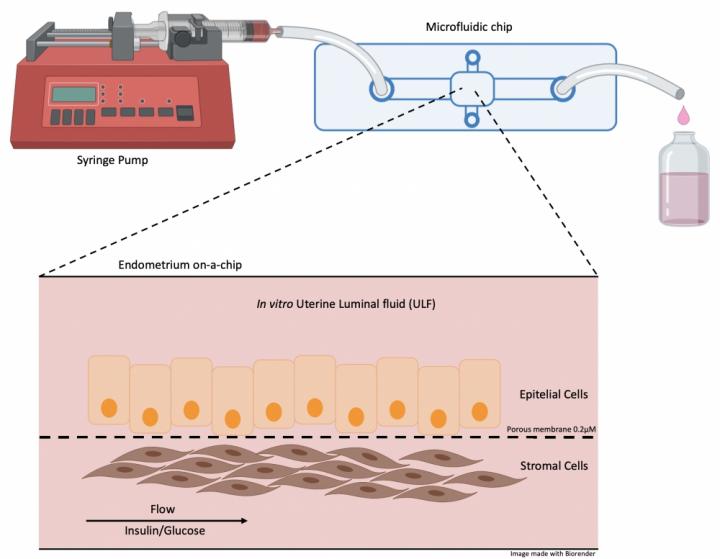The device was used for the first time to culture two maternal endometrial cell types, revealing the effects of alterations in glucose and insulin levels in the uterine environment
To investigate factors that can jeopardize pregnancy success in cattle, researchers at the University of São Paulo (USP) in Brazil used a kind of chip to mimic the environment of the endometrium, the tissue that lines the inside of the uterus.
The study was conducted by biologist Tiago Henrique Camara de Bem, a postdoctoral fellow at the University of São Paulo’s School of Animal Science and Food Engineering (FZEA-USP), in collaboration with four researchers at the University of Leeds in the UK. Their findings are reported in an article in the journal Endocrinology.
The researchers focused on analyzing alterations in levels of insulin and glucose in maternal epithelial and stromal cells, and the possible consequences for initial development of the pregnancy. Epithelial cells are the most external in the endometrium. They interface with the lumen and are in direct contact with the embryo. Stromal cells are further inside, acting as support cells that guide epithelial cell growth, differentiation and development, among other functions.
The group discovered that high levels of glucose altered 21 protein-encoding genes in epithelial cells and 191 in stromal cells, as well as triggering quantitative changes in the protein secretome (proteins secreted in the culture medium, which in this case mimicked the endometrial fluid). “As we changed the amount of glucose and insulin in the culture medium, stressing the cells, we were able to switch genes on or off, determining whether they were or weren’t expressed,” Camara de Bem said.
Changes in insulin levels altered the quantitative secretion of 196 proteins but resulted in limited alteration of gene transcription. “The key factor may be the protein composition of the uterine fluid, in which these cells secrete protein into the embryo,” he explained. “We found this group of proteins to be associated with signaling pathways that play an important role in early pregnancy success in cattle, relating to metabolism, cellular matrix and other factors. All these discoveries evidence a mechanism whereby maternal glucose and insulin alterations can affect uterine functioning.”
Camara de Bem was supported by FAPESP via a postdoctoral fellowship for a project conducted at the Molecular Morphophysiology and Development Laboratory under the supervision of Professor Flávio Vieira Meirelles, and a scholarship for a research internship abroad (BEPE).
Stress
According to Camara de Bem, Brazil is a world leader in the production of bovine embryos, but nevertheless has a high rate of lost pregnancies. “A large proportion of our embryos are produced by in vitro fertilization. Oocytes are collected, matured, fertilized, cultured and transferred to synchronized recipients. However, 40% of pregnancies are lost in the third or fourth week,” he said, recalling that a bovine pregnancy lasts about nine months, as in humans.
Reproductive success depends on a number of conditions. “Pregnancy is an interaction between the mother and the embryo that develops in the maternal uterus,” Camara de Bem said. “It involves cross-talk between the embryo’s cells and the mother’s. This communication is influenced by multiple processes. Pregnancy loss can occur when the communication isn’t right – when the embryo can’t signal its presence or the mother doesn’t recognize the developing embryo.”
Stress due to environmental or nutritional problems or even to the production process itself can lead to instability in maternal-embryo communication and disrupt the pregnancy, he continued. In the case of cattle, pregnancy in high-yield dairy cows is the main problem, with the initial post-partum period often involving metabolic stress due to a negative energy balance in the dam.
“Glucose, for example, is a basic substrate for cell metabolism,” Camara de Bem said. “Cells need glucose to perform their functions. Lactating cows undergo a metabolic challenge to produce milk. They consume a lot of energy because they need to maintain the basic functions of the organism as well as all the functions involved in milk production. The state of the mother’s metabolism significantly influences reproduction. Hence our focus on understanding the factors that cause metabolic stress in the environment that receives the embryo.”
Endometrium on a chip
Camara de Bem stressed that the study was conducted in partnership with the group led by Niamh Forde, a professor at the University of Leeds’ Medical School and last author of the article. “She’s investigating maternal recognition of pregnancy in cattle. I’m interested in investigating the signals sent by the embryo to the mother. We thought it would be a good collaboration and had this idea of developing an ‘endometrium on a chip’ that could be used for multicellular culture, i.e. growing more than one type of cell from the endometrium,” he said.
The chip resembles a histology slide, except that it is divided into chambers – compartments in which the scientists seeded two types of cell. The partitions are made of a porous membrane that enables information to be exchanged between the two cell types cultured in the different chambers but does not permit the cell types to switch positions. The device can be considered a commercial chip adapted to simulate an endometrium.
“Epithelial cells were seeded in the upper chamber, stromal cells in the lower,” Camara de Bem said. “Both cell types are abundant in the endometrium. The upper chamber’s culture medium became enriched with factors produced and secreted by the epithelial cells, representing the endometrial secretome.”
The chip enabled the scientists to infuse the cells constantly with a culture medium. “We cultured the cells for three days, injecting medium the whole time [one microliter per minute for 72 hours] with three different concentrations of glucose or two different concentrations of insulin,” he said. “Nutrients were administered very slowly, in a flow mimicking the best medium physiology. This ensured that the cells were exposed to the same levels of glucose and insulin throughout the experiment.”
Future
The method was innovative and had never been used before to mimic the bovine endometrium. Conventional cell culture is too simple to simulate all endometrial conditions. “The endometrium is three-dimensional, with several types of cells and glands producing factors and nutrients to maintain the pregnancy,” Camara de Bem recalled. “In vitro embryo culture using the traditional method is static and involves a single cell type in an environment that doesn’t reflect the richness of the animal organism. You can grow cells, transfer embryos to a recipient and produce healthy animals, but we set out to recreate the process in a manner that was as close as possible to the physiological reality.”
Camara de Bem noted that his partners at the University of Leeds are developing other kinds of chip for embryo insertion. “The methodology opens up a wealth of opportunities, and in future we hope to be able to culture cells and embryos together in order to find out exactly what happens when there are changes in the medium and in communication with maternal cells. This is an opening for more applied research,” he said.
The group’s work also offers a potential model for the study of pregnancy in mammals, including humans. “Except for non-human primates, mice are the main model for studying humans. Placenta formation in mice is the most similar to the process in humans. On the other hand, unlike us mice have many offspring. In cattle, placentation is very different from what it is in humans, but the gestational period is similar and cows also have only one offspring per pregnancy. There will never be an ideal model, because of the differences between species, but this can be one more model,” he said.
###
About São Paulo Research Foundation (FAPESP)
The São Paulo Research Foundation (FAPESP) is a public institution with the mission of supporting scientific research in all fields of knowledge by awarding scholarships, fellowships and grants to investigators linked with higher education and research institutions in the State of São Paulo, Brazil. FAPESP is aware that the very best research can only be done by working with the best researchers internationally. Therefore, it has established partnerships with funding agencies, higher education, private companies, and research organizations in other countries known for the quality of their research and has been encouraging scientists funded by its grants to further develop their international collaboration. You can learn more about FAPESP at http://www.
Media Contact
heloisa reinert
[email protected]
Original Source
https:/
Related Journal Article
http://dx.





